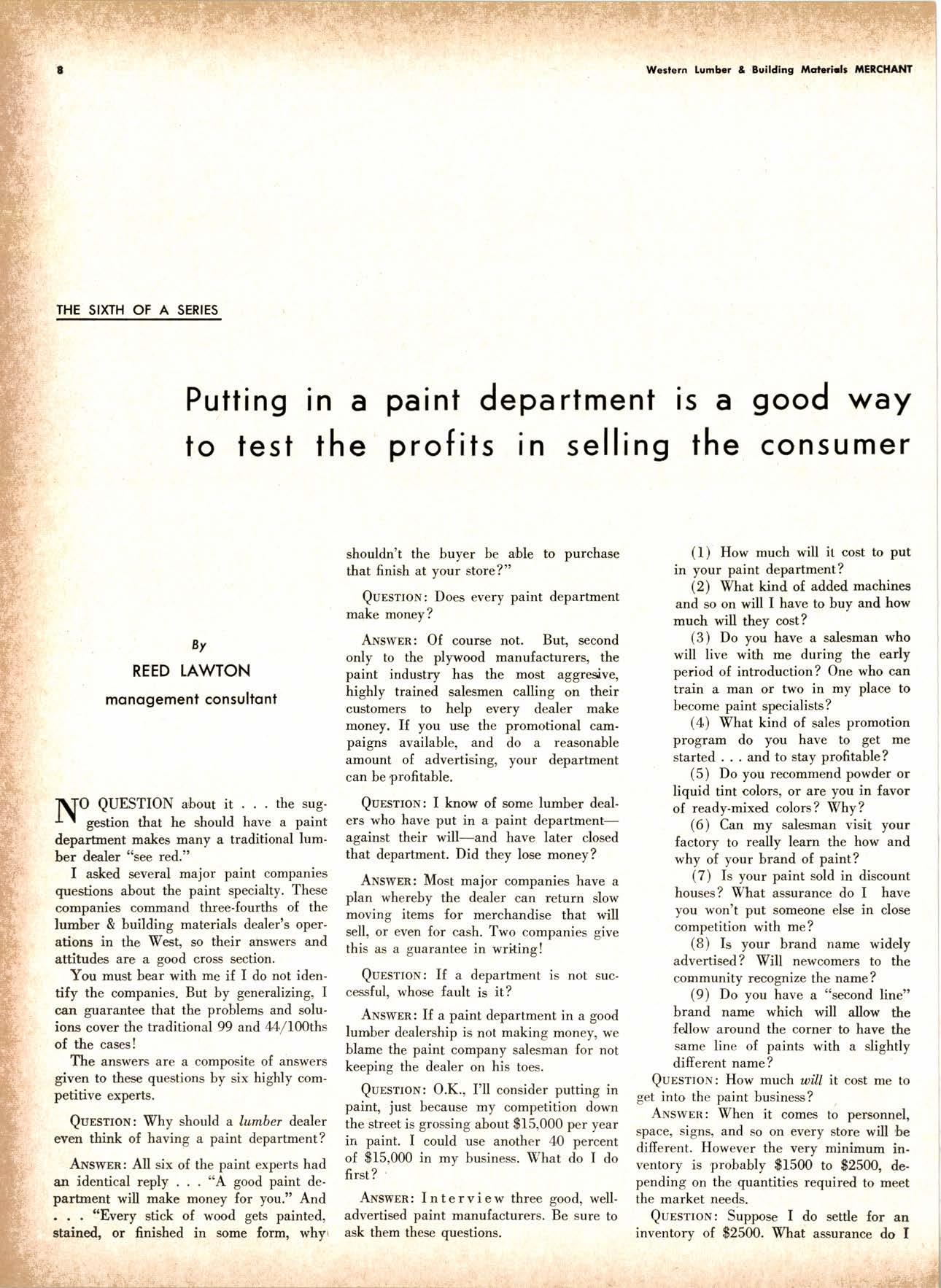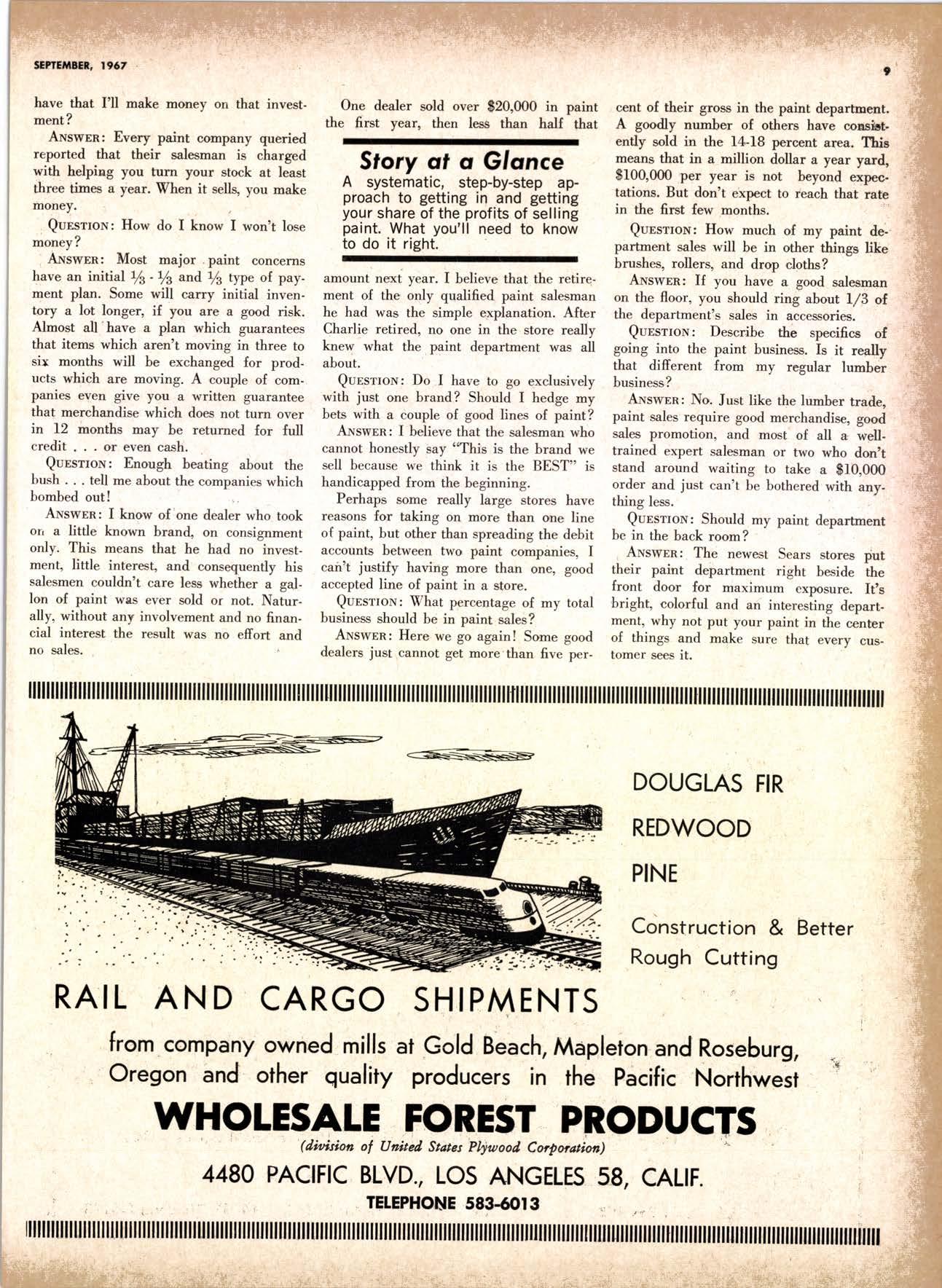
5 minute read
Putting in a to test the paint depa rtment a good way the consu mer is profits in selling
shouldn't the buyer be a,ble to purchase that finish at your store?"
QunsuoN: Does every paint department make money?
By REED TAWTON monogemenl consultont
N-O QUESTION about it the sugr \ gestion that he should have a paint deparhent makes many a traditional lumber dealer t'see red,"
I asked several major paint companies guestions about the paint specialty. These companies command three-fourths of the lumber & building materials dealer's operations in the West, so their ahswers and attitudes are a good cross section.
You must bear with me iI I do not identify the companies. But by generalizinS I can guarantee that the problems and soluions cover the traditional 99 and zl4/l0oths of the cases!
The answers are a composite of ahswers given to these questions by six highly competitive exp€rts.
Qursrron: Why should a lumber dealer even think of having a paint department?
ANswrn: All six of the paint experts had an identical reply . . ooA good paint deparhent will make money for you." And . "Every stick of wood gets painted, stained, or finished in some form, why,
Arswnn: Of course not. But, second only to the plywood manufacturers, the paint industry has the most aggresive, highly trained salesmen calling on their customers to help every dealer make money. If you use the promotional campaigns available, and do a reasonable amount of advertisin& your department can be profitable.
Qunstlolt: I know of some lumber dealers who have put in a paint departmentagainst their will-and have later closed that department. Did they lose money?
Attswnn: Most major companies have a plan whereby the dealer can return slow moving items for merchandise that will sell, or even for cash. Two companies give this as a guarantee in writing!
Qunsuou: If a department is not successful, whose fault is it?
Axswrn: If a paint department in a good lurnber dealership is not making money, we blame the paint company salesman for not keeping the dealer on his toes.
Qursuolt: O.K., I'll consider putting in paint, just because my competition down the street is grossing about $15,000 per year in paint. I could use another 4O percent of $15,000 in my business. Ifhat do I do first?'
(1) How much will it cost to put in your paint department?
(2) What kind of added machines and so on will I have to buy and how much will they cost?
(3) Do you have a salesman who will live with me during the early period of introduction? One who can train a man or two in my placo to become paint specialists?
(4) What kind of sales promotion program do you have to get me started and to stay profitable?
(5) Do you recommend powder or liquid tint colors, or are you in favor of ready-mixed colors? Vhy?
(6) Can my salesman visit your factory to really learn the how and why of your brand of paint?
(7) Is your paint sold in discount houses? What assurance do I have you won't put someone else in close competition with me?
(B) Is your brand name widely advertised? IVill newcomers to the community recognize the name?
(9) Do you have a "second line" brand name which will allow the fellow around the corner to have the same line of paints with a slightly different name?
Qunsrron: How much arill it cost me to get into the paint business?
Axswrn: When it comes to personnel, space, signs, and so on every store will be difierent. However the very minimum inventory is probably $1500 to $2500, depending on the quantities required to meet Awswnn: Interview three good, well- the market needs. advertised paint manufacturers. Be sure to QunsuoN: Suppose I do settle ask tlem these questions. inventory of $2500. What assurance do I sEftEtlGl, t9a7 : have that I'll make money on that investment?
Answrn: Every paint co'tnpany queried reported that their salesman is charged with helping you turn your stock at least three times a year. When it sellg you make money.
QursrroN: How do I know I won't lose monev?
Ar,lswnn, Most major paint concerns have an initial /s -7/s and,Va type of payrnent plan. Some will carry initial inventory a lot longer, if you are a good risk. Almost all'have a plan which guarantees that items which aren't moving in three to sir months will be exchanged for products which are moving. A couple of companies even give you a written guarantee that merchandise which does not turn over in 12 months may be returned for full credit . . or even cash.
Quusrrox: Enough beating alout the bush tell me about the companies which bombed out!
ANswnn: I know of 'one dealer who took orr a little known brand, on consignment only. This means that he had no investment, little interesl and consequently his salesmen couldn't care less whether a gal. lon of paint was ever sold or not. Naturally, without any involvement and no financial interest the result was no effort and no sales.

One dealer sold over $20,000 in paint the first year, then less than half that
Story d] d Gfonce
A systematic, step-by-step approach to getting in and getting your share of the profits of selling paint. What you'll need to know to do it right.
amount next year. I believe that the retirqment of the only qualified paint salesman he had was the sirnple eSplanation. After Charlie retired, no one in the store realy knew what the paint department was all about.
QunsrroN: Do I have to go exclusively with just one brand? Should I hedge my bets with a couple of good lines of paint?
Answnn: I believe that the salesman who cannot honestly say toThis is the brand we sell because we think it is the BEST" is handicapped from tJre beginning. Perhaps some really large stores have reasons for taking on more than one line of paint, but other tlan spreading the debit accounts between two paint companies, I cantt justify having more than one, good accepted line of paint in a store.
Qursnox: Vhat percentage of my total business should be in paint sales?
ANswpn: Here we go again! Some good dealers just cannot get more'than five per- cent of their gross in the paint deparmeat. A goodly number of others have consilt, ently sold in the 14-18 percent area. Thig means that in a million dollar a year yard, $f00,000 per year is not beyond expec. tations. But don't expect to leach that rate in the first few months.
Quesrroiv: How much of my paint de. partment sales will be in other things like brushes, rollers, and drop cloths?
ANswrn: If you have a good salesman on the floor, you should ring about L/3 ol t}e department?s sales in accessories.
Qursrrox: Describe the specific.s of going into the paint businesq. Is it reelly that different from my regular lumber business?
ANswrn: No. Just like the lumber trade, paint sales require good merchandise, good sales promofion, and most of all a welltrained expert salesman or two who donrt stand around waiting to take a $10,00O order and just can't be bothered with any. thing less.
Qunsrrox: Should my paint departrnent be in the back room?
ANswnn:. The newest Sears stores 1iut their paint department right beside the front door for maximum exposure. It s bright, colorful and an interesiing department, why not put your paint in the center of things and make sure that every customer sees it.










